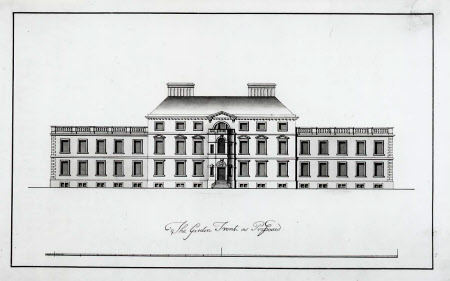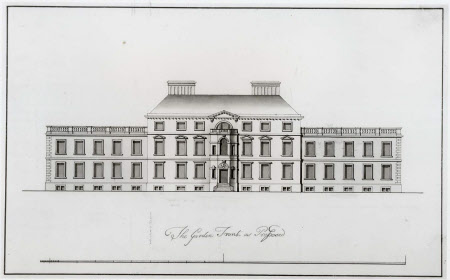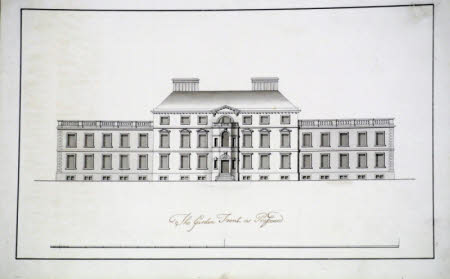Proposal for the remodelling of the north, or garden, façade of Wimpole Hall, Cambridgeshire
Henry Flitcroft (1697 - 1769)
Category
Architecture / Drawings
Date
circa 1742
Materials
Pen and ink with grey wash
Measurements
238 x 366 mm
Place of origin
England
Order this imageCollection
Wimpole, Cambridgeshire
NT 206209
Summary
Henry Flitcroft (Twiss Green, Cheshire 1697 – Hampstead 1769). Proposal for the remodelling of the north, or garden, façade of Wimpole Hall, Cambridgeshire, c.1742, inscribed 'The Garden Front as Proposed', pen and ink with grey wash (238 x 366mm), scale given.
Full description
If Flitcroft made a survey drawing of the then existing north elevation, it has not survived. He here repeats the formula of a tower of neo-Palladian elements - Diocletian window over Venetian window over entrance door - but imposes it on and above a canted bay added to the centre of the house. It sits beneath a small, open pediment at eaves level, enriched with dentils and supported on brackets. The classical canted bay was used by Nicholas Hawksmoor at Panton Hall, Lincolnshire (c.1720) and was an idea taken up by architects such as William Kent and Roger Morris (1695-1749). Its use - for example in the recasting of the garden façade of Carlton House, Pall Mall, for Frederick Prince of Wales (c.1733), and in an unrealised library addition (c.1748) to the Duke of Cumberland's Great Lodge in Windsor Great Park was to become a particular feature of Henry Flitcroft's work. In c.1750 the 3rd Earl Fitzwilliam commissioned Flitcroft to remodel his rambling, asymmetrically fronted Northamptonshire seat, Milton House; and in the refacing of its elongated south front, the architect placed a tower of Palladian elements at its centre and canted bays to either side. The component parts can all be recognised in his earlier work at Wimpole. The first Earl of Hardwicke's improvements may have spurred on his eldest son to employ Flitcroft at Wrest Park, Bedfordshire, where in 1760 he created a new dining room with a canted bay. At Wimpole, Flitcroft also appears to have added the five bay wing - or at least its façade - to the east, or left, of the central block. Prior to this, the northern face of the chapel would have been visible over the garden wall that linked the house and service wing, giving the garden façade of the house a decidedly unbalanced appearance. The addition may have been an afterthought for, other than as a sketchy, pencil emendation (NT 206207), it does not appear on the architect's plans. Flitcroft's written explanation, however confirms that the work was undertaken at this time. The bricklayer was 'To Build the Sham Front in the Garden with Butresses to D', while the mason was to provide '10 frames for blank Windows in the Sham Front'. Kenton Couse, Flitcroft's assistant, was later to finish this block and to build within it a new, neo-classical dining room (NT 206190). Catalogue entry adapted from David Adshead, Wimpole Architectural drawings and topographical views, The National Trust, 2007.
Provenance
Sir Philip Yorke, 1st Earl of Hardwicke, Lord Chancellor, PC, FRS, (1690-1764); bequeathed by Elsie Kipling, Mrs George Bambridge (1896 – 1976), daughter of Rudyard Kipling, to the National Trust together with Wimpole Hall, all its contents and an estate of 3000 acres.
Marks and inscriptions
Above scale: The Garden Front as Proposed
Makers and roles
Henry Flitcroft (1697 - 1769) , architect
References
Adshead 2007: David Adshead, Wimpole Architectural drawings and topographical views, The National Trust, 2007, p.41, no. 48



